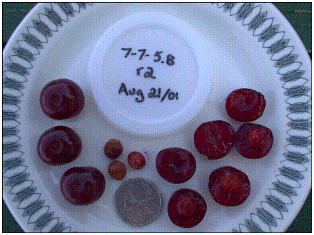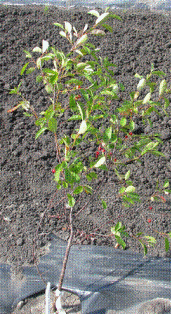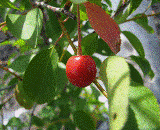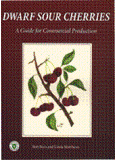Prairie Hardy Dwarf Sour Cherries: Each Cultivar has Unique Qualities

Photo courtesy Dr. Bob Bors
The breeding of dwarf sour cherries began in the 1940's by Dr. Les Kerr. The past 50 years of breeding have combined cold hardiness, dwarf stature of Mongolian cherry (Prunus fruiticosa) and good fruit quality of sour cherry (Prunus cerasus) into the final product, hybrid dwarf sour cherry. The cherry releases by the University of Saskatchewan (Dr.Bob Bors Fruit Program) are a great tasting cherry with a high sugar content. They are grown on their own root stocks so there are no grafting issues. They also have very good potential for mechanical harvesting which is necessary for commercial fruit production. Their round pits make it ideal for processing with mechanical pitters. These cultivars will grow 8-12 feet tall, can be pruned to be more shrub like. Flower are self-pollinating by bees, so do not need more than one cultivar for fruit set. Expect large fruit production 4-5 years after transplanting with yields 4-10 lbs per plant. Cultivars are demonstration at PFGA Research Orchard– CMCDC Portage Station. Approximately 10 acres of commercial orchards in Manitoba in 2010.
The breeding of dwarf sour cherries began in the 1940's by Dr. Les Kerr. The past 50 years of breeding have combined cold hardiness, dwarf stature of Mongolian cherry (Prunus fruiticosa) and good fruit quality of sour cherry (Prunus cerasus) into the final product, hybrid dwarf sour cherry. The cherry releases by the University of Saskatchewan (Dr.Bob Bors Fruit Program) are a great tasting cherry with a high sugar content. They are grown on their own root stocks so there are no grafting issues. They also have very good potential for mechanical harvesting which is necessary for commercial fruit production. Their round pits make it ideal for processing with mechanical pitters. These cultivars will grow 8-12 feet tall, can be pruned to be more shrub like. Flower are self-pollinating by bees, so do not need more than one cultivar for fruit set. Expect large fruit production 4-5 years after transplanting with yields 4-10 lbs per plant. Cultivars are demonstration at PFGA Research Orchard– CMCDC Portage Station. Approximately 10 acres of commercial orchards in Manitoba in 2010.
Cultivar Details

3 year old sour cherry
Carmine Jewel - small pit (therefore more fruit per cherry), dark red/ black when ripe, 3.5 g fruit size, earlier maturing (late July top early August), low suckering, large showy flowers (good ornamental), good for processing and fresh eating. First to be released, more widely available.
Valentine - very productive, this is the most productive of the selections, slight suckering, fruit size about 4.5 grams, bright red colour.
Crimson Passion - highest sugar content (up to 22 brix), excellent fresh eating cherry, very low suckering, fruit size is large at 5.8 grams per fruit, , small bush, slower rooting, small flowers.
Juliette – very sweet (brix up to 20), good fresh eating type, large fruit at 4.5 grams, low suckering.
Romeo - Best for juice, dark red/black cherry similar to Carmine Jewel appearance but ripens later, very flavorful, good for fresh eating/ processing.
Cupid – Latest ripening (blooms 1 week later than the other sour cherries), most years largest of all the cherries at 6 to 7 grams, good flavor for fresh eating (hint of astringency).
These varieties will be available at your local nurseries next spring, for bulk wholesale orders order well in advance to ensure availability.

Always harvest cherries when dark red in colour, not light red as in the photo. - MAFRI photo A. Mintenko
Potential Markets: Fresh eating (u-pick and pre-picked), processed into pies, dehydrated (like raisins), juice, various baking goods.
For more articles on sour cherries and to order the Dwarf Sour Cherry Guide for Commercial Production visit: www.fruit.usask.ca

